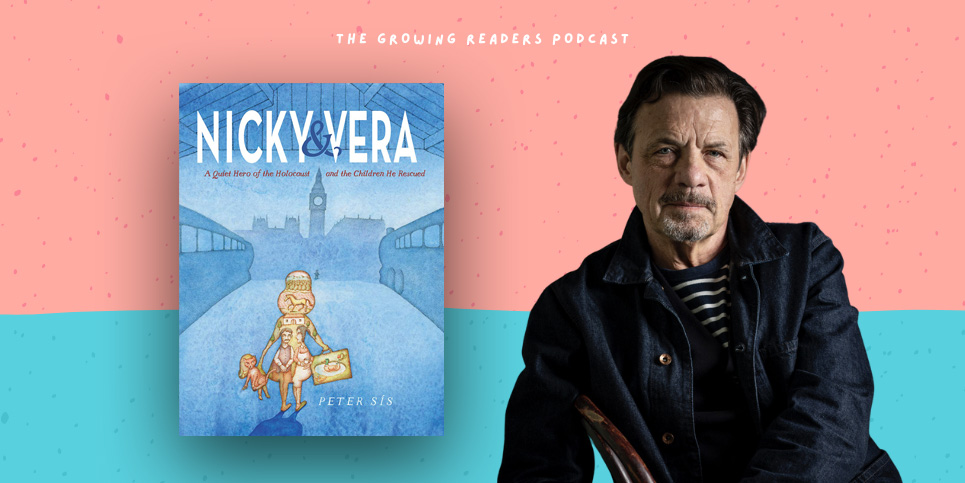An interview with Peter Sís
The Children’s Book Review
In this episode of the Growing Readers Podcast, Peter Sís and I talk about the poignant and stunning picture book he created, Nicky & Vera: A Quiet Hero of the Holocaust and the Children He Rescued. A devastatingly beautiful story that highlights the unassuming power of one.
Wow! I feel so lucky to have had this conversation with such a wonderfully talented man, and I am even more excited to share our discussion with you. We never intended to turn this over-the-phone chat about Nicky & Vera into a podcast episode, but it begged to be shared. We talk about what it means to be a hero, the research and history behind his new book, creating art during a pandemic, and so much more. Peter Sís is down-to-earth, creative, and thoughtful. You’ll come away with an understanding of why his award-winning artwork evokes so much emotion in his readers. I know I did!
Listen to the Interview
Read the Interview
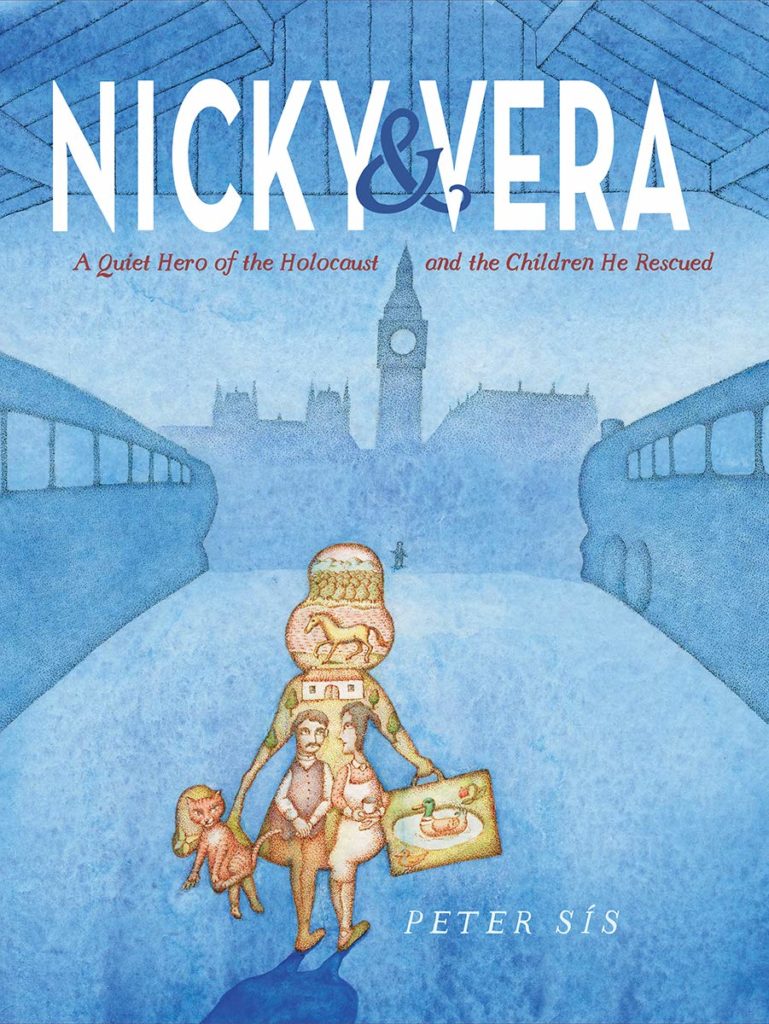
Bianca Schulze: Well, first of all, I just want to say that I think the book is gorgeous—which I wouldn’t have expected any less from you—and I just think the whole story is incredibly moving.
Peter Sís: Thank you so much.
Bianca Schulze: You’re welcome!
Bianca Schulze: The back story of how your book came to be is very meaningful. Will you talk about the trip you took to Prague with your son and the inspiration for Nicky & Vera: A Quiet Hero of the Holocaust and the Children He Rescued?
Peter Sís: Sure. My son was 15, so it was ten years ago … being from Prague, I knew bits and pieces of the story. This story was with me my whole life about people who went to England on the trains—people who survived the war. However, when I was young, there was no knowledge of a person like Nicolas Winton—his story was not uncovered until the 80s.
When my son was 15, on the way to the Bologna book fair, we stopped by in Prague so I could show him, like, father and son, before he gets too old, my favorite spots in Prague. My Czech publisher said to come to the National Museum and that there will be some event. I went with my son and the lobby was full of people—middle-aged people cutting a big giant cake with a steam train or steam engine on the top. They talked about Nicholas Winton, who was just celebrating his hundredth birthday—he wasn’t there. This brought up the question with my son of who was Nicholas Winton? What made him a hero?
We talked a lot about heroes—sports heroes, moral heroes, war heroes, and science heroes. In my previous books, Starry Messenger: Galileo Galilei and The Tree of Life: Charles Darwin, these are very visual, visible heroes to people. But with Nicholas Winton, here was a low-key man, unassuming his whole life, never saying anything about his heroic efforts. It was a sort of fascinating thing because people only, in time, fifty years after the war, found out that he was responsible for saving almost 700 children from pre-war Prague. Nicholas always said, “I am not a hero. I wasn’t ever in danger.”
In 1938, just before Christmas, he was just a young stockbroker living in London. He planned to take a ski vacation with a friend, Martin Blake; but Blake asked to meet in Prague instead. In October of that year, Germany had occupied the border area of Czechoslovakia called the Sudetenland. In November, Jewish homes and businesses in Germany and Austria were attacked on a night known as “Kristallnacht.” By December, Prague was filled with some 250,000 Czech and Jewish refugees living with few resources in freezing conditions. Winton was only 29, but he knew that there would be a world conflict and that he had to do his part to save as many children as possible.
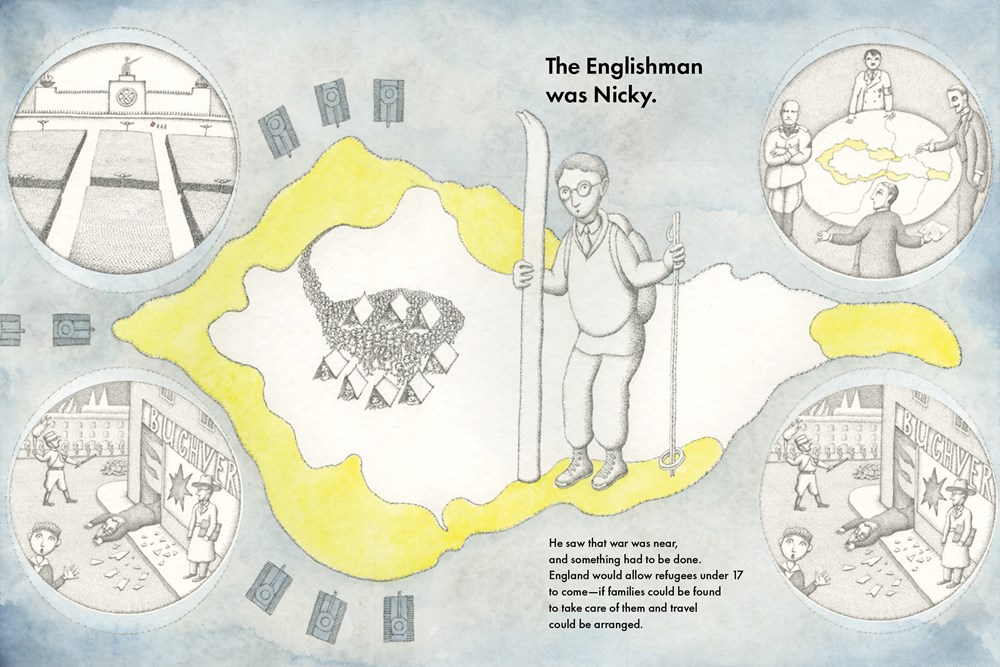
He sets up an office in Prague, and immediately people hear about it. From 6 a.m. until late night, families – mostly mothers—come to sign up for this train to England. Nicholas is an excellent administrator, he knows exactly everything to do and he sets this whole thing up in three weeks in Prague, from the hotel. He returns home and has this whole operation set up between Prague and London with his mother. He goes to work every day to count whatever it is stockbrokers count, and in his spare time, he puts ads in the newspapers looking for families who would take a foster child. He finds out that the best pictures are if the child is smiling—and so he uses all the tricks.
It is only three months before the war will start, except nobody knows that at that time. The first train with the children leaves in March, and this is just the day when the Germans take over the Czech protectorate —Czech and Moravia—because Slovakia becomes a fascist state independent of this. So, the Germans marched in in March when the first train is leaving, and after that, seven more trains go through. The last train, which is supposed to be the ninth train, with 250 children, is supposed to be leaving September 1, 1939, and that’s the day the war breaks out and the Nazis attack Poland. So, the train never leaves. In Nicky & Vera, I took the liberty to show the train being stopped on the border, but the train never left, and I think almost all the children were never accounted for.
Once the war breaks out, he knows it’s over for him—that he can’t do anymore. He always believed he could have saved thousands of children if he had got more responses. He goes on with his life. He puts all the documents he’s got left or given to him in Prague into a crate and doesn’t talk about it after the war. He meets this wonderful Danish woman, and they get married, have three children, and he works in various positions. He establishes a whole chain of assisted living homes for the elderly in England called Abbott Houses. His children grow up and, one day, his wife is cleaning the attic and finds the crate of papers. She insists that these papers have a lot of meaning and takes the crate to somebody who is writing books about the Holocaust. The whole story becomes public.
Winton’s wife and the woman who was writing the book try to contact the children—they only have the addresses from the time of the war. They hear back from about 200 children. Not long after, Winton is invited to appear on a famous television program on the BBC, but he thinks it is about the retirement homes (or something). He has no clue that it’s about what he did during the war. There are all these people fighting to sit next to him; he doesn’t understand why. It is only when the show’s announcer introduces him as the man who saved children during the war that he realizes she is talking about him. And then she asks anyone in the audience who came on the trains to please stand up. The people surrounding him stand up. Vera Gissing had been sitting next to him. It was the first time that all these people would see his face and know who was behind their escape. Until this moment, he never talked about it. He was so touched, in a reserved way, and was wiping tears from his eyes.
I knew that it was impossible to do just the story of the good man who then, in the end, is rewarded for being so nice. When I read Vera Gissing’s book—she was a little nine-year-old girl living in a friendly small town outside of Prague in 1938—I knew this to be a counterpoint to what was happening in the world. Her mother, being cautious, signed her up for the train to England, thinking maybe she will go for two or three months, stay with the family, and she will become a hero in the village because she will go so far to the Kingdom of England, where they have a King. Everything is settled before tragedy strikes, and the German army marches in. They start to see the danger rising, and they are counting the days until she leaves. She kisses all of her relatives goodbye. Her cousins are supposed to follow on another train, but that will be the train that never makes it.
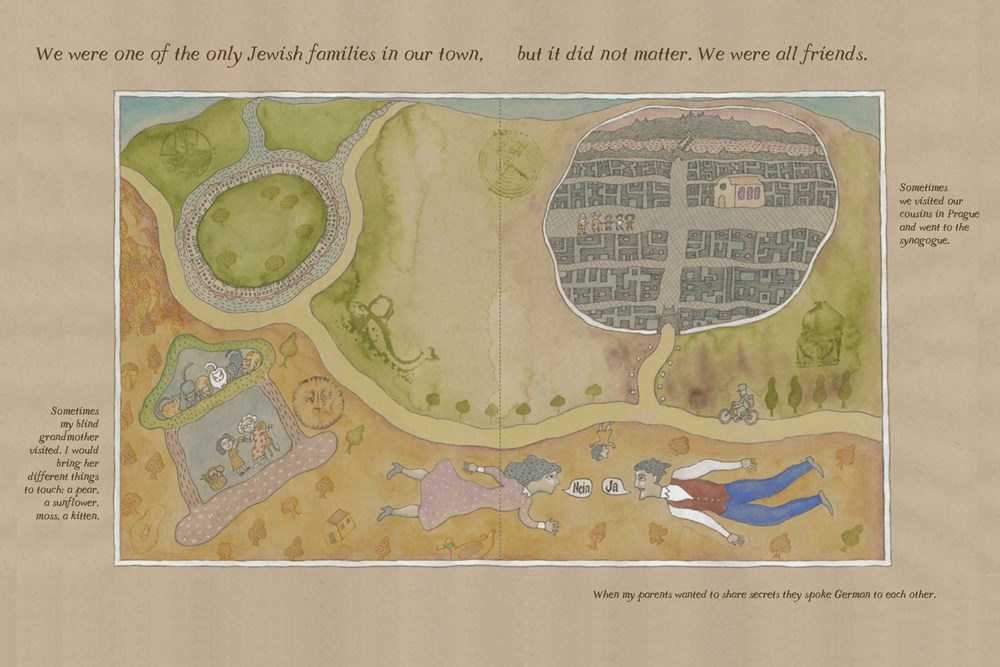
When she comes to England, she writes letters for three months to her parents, and her parents write back because they can still get letters to each other from Switzerland. Then, all of a sudden, everything goes quiet … and then the war begins. She doesn’t know until 1943 when she hears about what’s happening to Jewish people and the concentration camps from the BBC. Eventually, she returns home to Prague but decides she can’t stay there because the house still looks the same, but everybody vanished in the Second World War. In Nicky & Vera, I sort of jumped the whole period when she has her family, and Nicholas Winton has his family. Then Vera is invited to come to this BBC studio, as Nicholas is, and when the story is told, they realize that they are connected, along with all the children, who are now in their sixties to seventies. Nicholas Winton became a symbol and inspiration to many all over the world.
My son and I barely missed him at the National Museum. He was waiting for all the people from Prague to get on the same train and travel the same route exactly, fifty years later, to Liverpool Street Station in London. He was waiting for the train in his wheelchair. He lived six more years.
Nicholas Winton always denied that he was a hero, but then I discovered an ancient definition of what a hero is “One who defends.” He really was a hero—defending decency and humanity. And until now, I didn’t think about it, how it is connected to all the refugees of today coming through Greece or coming through Mexico—that, the parents, when they are desperate and looking for some sort of solution for their children, would agree that the children should go alone.
Bianca Schulze: I watched the 60 Minutes clip and the BBC clip [see show notes below], and I spent a good portion of yesterday afternoon with tears in my eyes. I’m at a little bit of a loss for words, but it’s such an incredible story. And the fact that this wasn’t a public story—that Nicholas did keep it to himself…
Peter Sís: It’s incredible that he never looked for any recognition. Especially when today, everybody is looking for some social media recognition.
Bianca Schulze: Right.
Peter Sís: And that moment when he tears up in the BBC studio– it is probably the most touching moment on television because it’s so sincere. So, I’ve realized that, because this book took some time—and you never know what will be happening in the world when your book comes out—I don’t know where it fits– because this is very strange times indeed.
Bianca Schulze: Yeah, it is. Well, I wanted to ask you: all of your books are deeply personal, and I was wondering about the timing of when you created the art-work and when you were going over the proofs – how did working on this book differ from any of the other books that you’ve worked on?
Peter Sís: Well, creating this book went on for a long time. I got stuck way before COVID. How do I make it work? He’s so good that it’s impossible to do because everything is positive from the outside —Nicholas Winton’s just such a really, really good guy. It was almost impossible to write. How do you do a book like that? And then, I think it was my wife’s idea to split the stories of Nicholas and Vera.
They were not parallel in age, but both of them start the book when they are children. On the first page of the book, we see the twentieth century was so full of promise with all the inventions and technology and ideas that people would have equal wealth and stuff like that, and then – bang! – the first world war, and then – bang! – the second world war, and everything was upside down. And so, I thought it was a good message of how somebody can step up and help. In my life, I probably could have helped much more often, but I wouldn’t think of it because it wouldn’t be the norm. When Nicholas was going skiing, he could have said, “Well, this is terrible, these children are in big trouble, but we already paid for the hotel, so I’m going to ski.” He didn’t do that, and that I admire. I can see how my children, who are now grown up, think about it and make these kinds of decisions. This story does not tell us how to do it but highlights somebody who wouldn’t be an obvious hero.
I’m in touch with five very wonderful people who were children on the train. They all are trying to do something which would be benefitting society, talking about what happened—they all are dedicating their lives to do something for society. So, it’s still this whole story for me, and I’m still discovering more and more things about it.
Bianca Schulze: You know, everybody says not to live in the past. Be present—plan for the future.
Peter: Yes, always.
Bianca Schulze: But, if we don’t remember and we don’t look back at the lessons to take away, and the message of resilience as well – these are so important. That’s why I think your book fits – that we need the message that there’s always hope, we need to be resilient, and take a moment to do something that is for others instead of ourselves.
Peter: Yes, it is very valuable, that is it exactly.
Bianca Schulze: Making the choices like Nicholas Winton did, as you said, he could have gone on that vacation, but he didn’t, he saw something that needed to be done and he chose to do it.
Peter Sís: Right. It was also a message about human decency and about people being together.
Bianca Schulze: I forget if it was the Sixty Minutes or the BBC, but one of the journalists pointed out that Nicholas Winton saved almost 700 children.
Peter: Right.
Bianca Schulze: Which now, that number, based on their growing families, is about 1,500. That’s 1,500 lives!
Peter Sís: Yes, yes. I think even more. I think that’s wonderful too. I wanted to have a tree of life at the end of the book to show this. It’s a very good point—that from these 669 children, the number is now in the thousands. It just shows how humanity works.
One of the children sent me the English newspaper page with the ads of English people—mostly working-class English people in 1938—who are responding, offering that they will take a child to their home—and it’s absolutely touching. So wonderful.
Bianca Schulze: I wanted to ask you about the color palette that you used because for both Nicky and Vera, it’s different, and yet the color palettes also intertwine. So – can you share a little bit about your artistic thinking and that choice of the different colors?
Peter Sís: Well, I wanted Vera to be innocent because she said in her book, she never experienced evil or mean people or somebody speaking badly to her until she was nine. The first time she experiences some horror or some danger is when the German army comes to their house, and the officer treats her father very badly. And then she’s in shock because she had had this very innocent and beautiful childhood. So, I wanted these pictures to be like children’s pictures, but then again, I think children’s drawings are ingenious because they don’t think of what it’s going to look like; they just are happy to draw. So, I came up with the idea of a colorful, idyllic landscape. There was the idea from the beginning that she would be in this very colorful, innocent world, which then changes with the trip on the train.
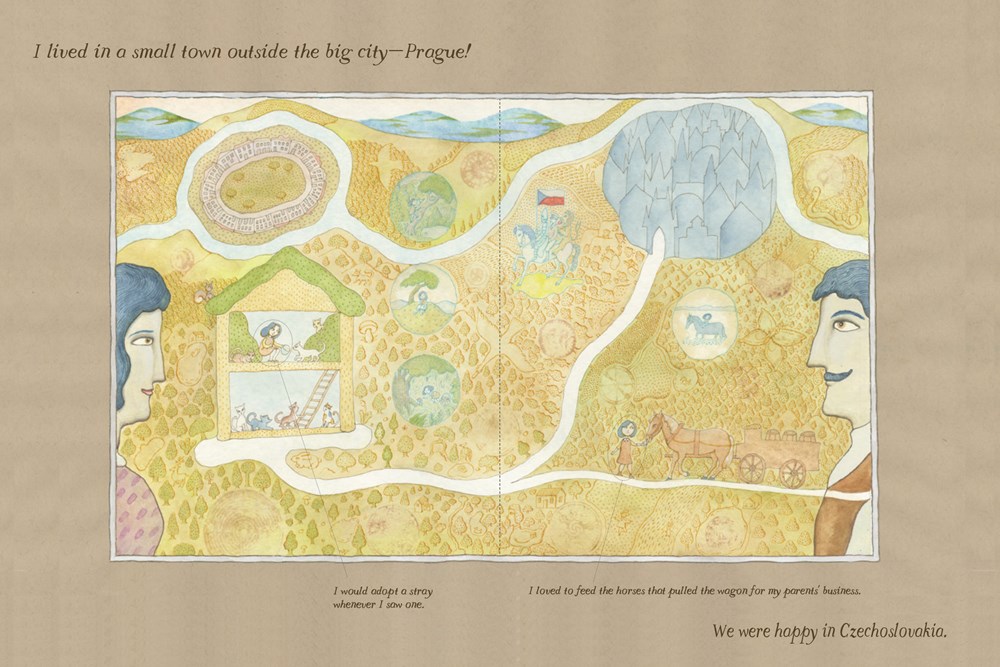
I had to come up with a contrasting, more dramatic color of Nicholas Winton – not that he wasn’t an amazing person, but he’s very guarded, very reserved, and an English gentleman of the time. He went to this amazing, revolutionary school in England, which had just opened in Stove. They had a new, radical curriculum thanks to the principal. I have a picture of this – so they could keep any pets they wanted, and it says in the book that somebody has a hyena, and somebody has a goat – and the motto of the school is “Put needs of others first.” And I thought it’s sort of fitting for Nicholas’s life. The school was the foundation for him to think independently—though he must have been empathetic as it is. For me, because Nicholas wasn’t ever showing too much feeling—it wasn’t the time to be very emotional or to be very descriptive. So, this one color, this sort of indigo with yellow, was fitting for him, so he would be more reserved for the time when the war is imminent.
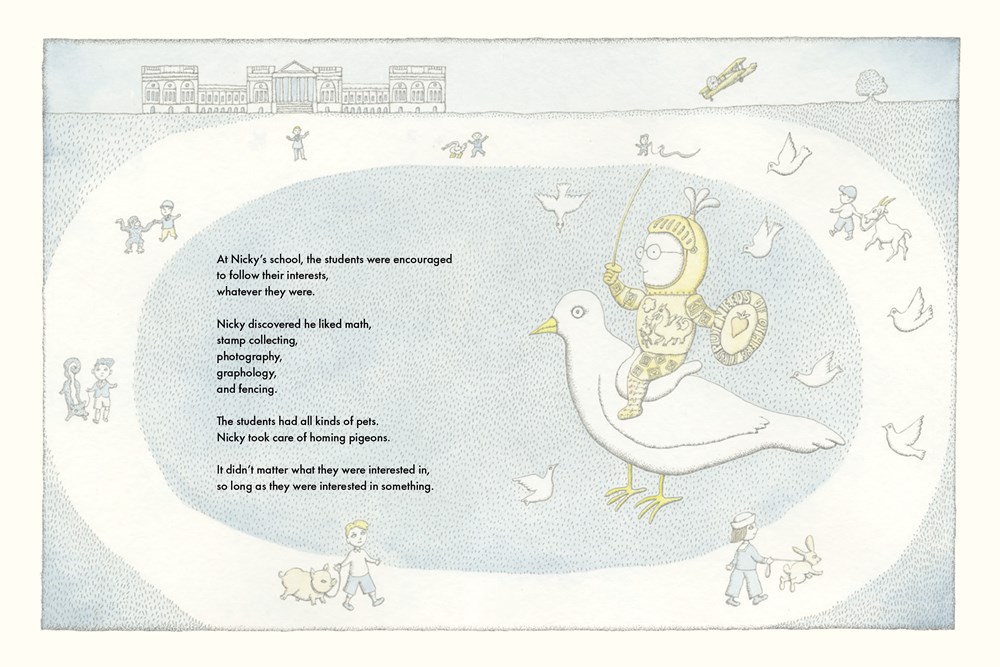
When I was looking for something contrasting for Vera, the art director then came up with this idea of brown frames around Vera’s pictures because it was the color of the box in which she brought her things with her to England. And because I had this second sort of bluish color of Nicholas, I used all the yellows when I wanted to make a point of the Germans taking over Czechoslovakia’s border regions. Having Nicholas is in the bluish color helped me to switch from one level to another level. Because Vera was done in these child-like colors, I didn’t have to (I didn’t want to) get into the cruelty of some moments and the bleakness—there could still be the hope of a little child that everything will be okay.
When Vera comes out on the train station, at Liverpool Street Station in London, the last child—all the other children are gone—she waits to meet her family. Here the colors become bleak because of the war, and through the diary and the years passing, I tell the story of Vera (simplifying the end of the war) coming home when she finds that nobody survived the war. She cannot live in this same place again. So, Vera goes back to England, where she now feels more at home.
For the scene in which Nicholas and Vera meet in the television studio, I didn’t dare to put in any colors. Because everybody was thinking about how they were when they were little children on the train—this must be something I don’t know (we don’t know) enough about unless you live it, I guess. It must have been so strange for them, lots of buried memories from when they were little—smells, tastes, but some things completely forgotten. These are the feelings I wouldn’t dare to describe because everybody must have a different feeling. This is how I came up with the idea of the tree of hearts monument that I have on the last page because all these people loved Winton, and he loved them back.
Bianca Schulze: I felt so moved by that particular double-page spread of everybody in the BBC show with all the figures—all the adults—with the overlaying image of their childhood self, and just the words “everyone stood up” —this page really stands out to me. I wanted to ask you about the tree of hearts, which you already touched on. And Vera’s silhouette on the book cover filled with all of the multiple illustrations of her childhood … that gets me, I love that.
Peter Sís: Thinking about the television show, when Nicholas came to the studio not knowing what it was all about—it’s so very touching, the whole thing—I couldn’t have painted that, so this is why they all are standing, and everybody has a little child inside of them.
And the tree with the hearts is something which I can’t put in words because everybody felt so much love. I was trying to show not only the emotions but the tree of life was also what you said about that the 669 children are now maybe 6000 —that there are families who say that without him, they wouldn’t exist, really, so—it’s to show how things work in time.
Bianca Schulze: Let’s talk about the British red bus with the Typhoo Tea branding (which I Googled, and I guess it’s a very popular tea that has been around since 1903). I was curious as to why you picked Typhoo Tea.
Peter Sís: I think it was just my memory of London, because I grew up in the same country as these children, in Czechoslovakia, but there was the iron curtain or the wall, and our dream was to go to England. When I got to England for the first time when communists opened up the border a little, I just have this memory of double-deckers in London that they had this Typhoo Tea on them. I know that the editor of the book (who comes from England) was laughing. It’s more my sentiment than it would be Vera’s sentiment. It was just to show it was England, and that’s why I have the red phone booth and the double-decker, because that, for me, was sort of symbolic for London or England.
Bianca Schulze: I want to ask you a couple of quick questions, just about you. What’s on your nightstand? Do you have any books on your nightstand?
Peter Sís: Yes, I have a book on Washington Irving because I want to do a project on him. We lived next to his house for years, and he was quite intriguing—an American writer who’s now almost completely forgotten. I have a new Czech book my Czech publisher has sent me from Prague. And … a beautiful little book which I bought in Northampton – and it’s called A Month in Sienna by Hisham Matar. I also read lots of books about the history of rock and roll—that’s just because of my music background.
Bianca Schulze: Can you tell us something that even your most loyal fans may not know about you?
Peter Sís: Hmm. That I met with the Dalai Lama. This feels like showing off.
Bianca Schulze: Did you meet the Dalai Lama? Oh my goodness, that’s amazing!
Peter Sís: Yes, when I did the Tibet book, I met the Dalai Lama. I was the most famous disc jockey in Czechoslovakia and went on the tour with the Beach Boys in 1969 to be the MC of the Beach Boys’ show.
Bianca Schulze: No way!
Peter Sís: Yeah.
Bianca: Oh, I love the Beach Boys.
Peter Sís: I would go, “Ladies and gentlemen, here they are – from California – the Beach Boys!”
Bianca: That’s awesome!
Peter Sís: In ’69, I did interviews with all the most famous groups from Led Zeppelin to the Beatles to Eric Clapton. I was in London with my tape recorder because I was doing all these interviews for my radio show. I would always draw a little portrait of whoever I was interviewing, and then I would write an article because I was writing a lot about music at that time, but I was still living in Prague, so that was like a previous life.
Bianca Schulze: That’s amazing.
Peter Sís: It’s amazing now because I wouldn’t dare that much to go and say, “Hey, can I do an interview with you?”
Bianca Schulze: I feel like you need to write your autobiography or a memoir, because your life, I’m sure, is so fascinating.
Peter Sís: I want to do it with the central idea of coming to America, because there was this whole misunderstanding, and it’s about Maurice Sendak and me, so that’s the idea. I would do that, but I have to hurry up while people still remember me. I thought I would be doing lots of books through this pandemic, but in a way, it takes the spirit away, it goes—everything goes very slowly, somehow.
Bianca Schulze: It’s such a strange time.
Peter Sís: Some illustrators, some musicians like Paul McCartney, said he created a whole record—some people say they can work that much better because they are in isolation, but it doesn’t work for me like that.
Bianca Schulze: No. Well – you probably need your outside inspirations.
Peter Sís: Absolutely.
Bianca Schulze: Is there anything else you’d like to share about yourself, Nicky and Vera, or any of your future books?
Peter Sís: Somebody told me that the term hero applied to anyone, godlike or mere mortal, who took it upon himself or herself to defend, in whatever way they could. So that I think is like Winton, he defended in whatever way he could the humanity and hope and decency. And so that I would leave as an answer for the last question.
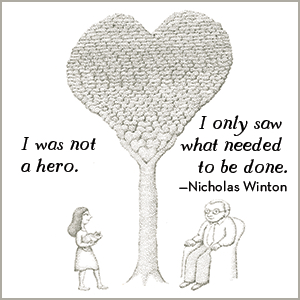
Bianca Schulze: That’s beautiful, Peter – thank you so much – I really enjoyed our conversation.
Peter Sís: Thank you very much.
The transcription of this interview with Peter Sís has been condensed and edited for readability.
About the Book

Nicky & Vera: A Quiet Hero of the Holocaust and the Children He Rescued
Written and Illustrated by Peter Sís
Ages 6-8 | 64 Pages
Publisher : Norton Young Readers | ISBN-13 : 978-1324015741
Publisher’s Synopsis: In 1938, twenty-nine-year-old Nicholas Winton saved the lives of almost 700 children trapped in Nazi-occupied Czechoslovakia―a story he never told and that remained unknown until an unforgettable TV appearance in the 1980s reunited him with some of the children he saved.
Czech-American artist, MacArthur Fellow, and Andersen Award winner Peter Sís dramatizes Winton’s story in this distinctive and deeply personal picture book. He intertwines Nicky’s efforts with the story of one of the children he saved―a young girl named Vera, whose family enlisted Nicky’s aid when the Germans occupied their country. As the war passes and Vera grows up, she must find balance in her dual identities―one her birthright, the other her choice.
Nicky & Vera is a masterful tribute to a humble man’s courageous efforts to protect Europe’s most vulnerable, and a timely portrayal of the hopes and fears of those forced to leave their homes and create new lives.
Buy the Book

About the Author
Peter Sís is the Czech-born author/illustrator of three Caldecott Honor books, including The Wall, which also won the Sibert Medal. He is the first children’s book illustrator to win the MacArthur Fellowship, and also won the Hans Christian Andersen Award. He lives in Irvington, New York.
Show Notes
Thank you for listening to the Growing Readers Podcast episode: Peter Sís Discusses Nicky and Vera: A Quiet Hero of the Holocaust and the Children He Rescued. For the latest episodes from The Growing Readers Podcast, Follow Now on Spotify. For similar books and articles, you can check out all of our content tagged with Growing Readers Podcast, Holocaust, and Picture Book.

